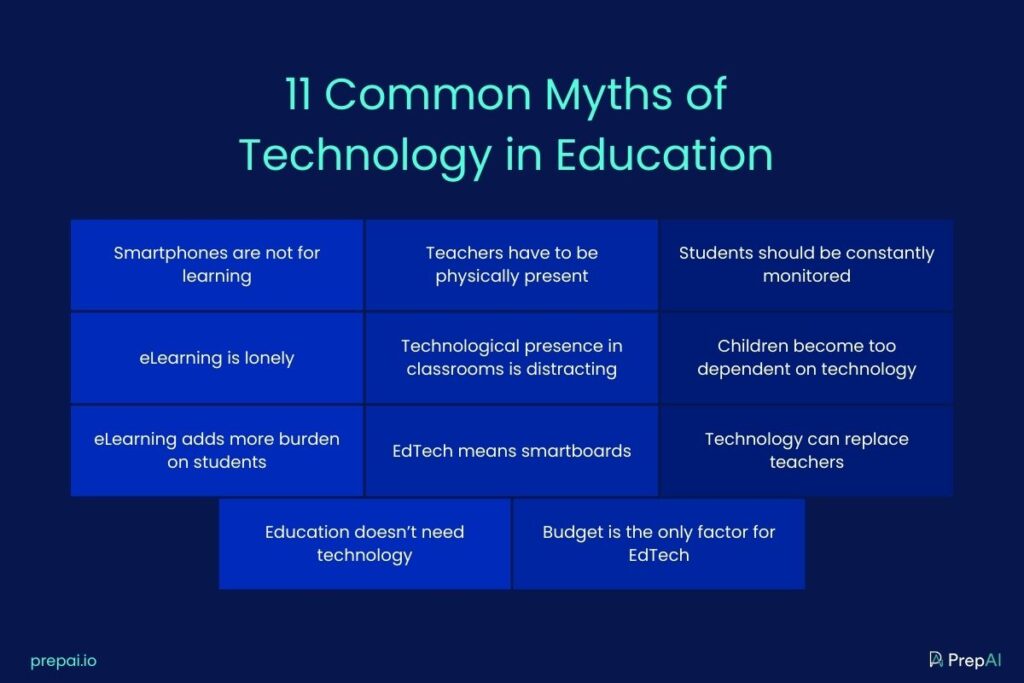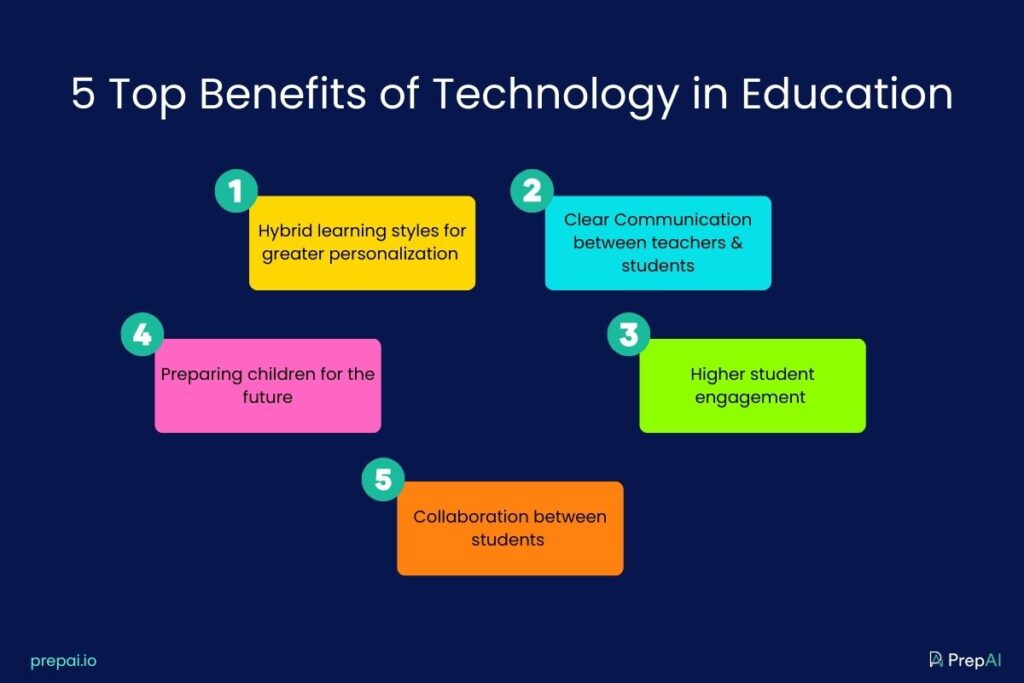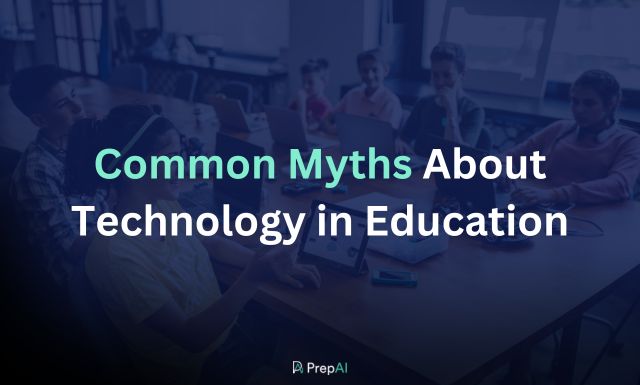Several misconceptions are prevalent in society about the role of technology in education. While there are a few challenges in adopting EdTech, these can be easily overcome with proper planning. Here, we’ll discuss the popular myths about technology in education and debunk them.
According to Global Newswire, the EdTech industry is expected to touch $605.8 billion by 2027. The same publisher also reported that the LMS (learning management systems) market will reach $42 billion by 2027. There’s no denying the use of technology in education and its growing importance in the future.
However, many myths and false statements float in the market, leading to hesitation, confusion, and resistance. In this blog, we attempt to bust the myths around technology in education and present a clear picture of EdTech and its prominence in the industry.
What Is Technology in Education?
Education technology is the use of technology and IT tools to develop a flexible, engaging, and customized learning experience. It combines software tools and modern teaching methodologies to create an inclusive and holistic classroom where the learning process is student-centric. From 3D technology to VR headsets, LMS systems, and assessment tools, technology in education is varied and implemented on multiple levels.
As per a report by Eric.ed.gov, close to 60% of parents (with kids in K-12 grades) believe that integrating technology into classroom education is a good way to help kids learn. In fact, more than 80% of parents consider technology important for their children’s education. Another study highlighted that gamification of assessments improved performance and results by up to 60%.
The ultimate aim is to reduce the workload on teachers, optimize the use of resources for educational institutions, and enhance the learning experience in students.
Common Myths of Technology in Education
Though the statistics are encouraging, people are still wary of technology in education and its negative effects. So, what are the misconceptions about technology in education? Let’s find out and debunk them.

1. Smartphones Are Not for Learning
Education and learning are not the first things that come to mind when we think of smartphones. Most kids love to play games on mobile phones, which makes parents doubtful about the role of these devices possess as potential learning tools. However, the pandemic has proved to be otherwise.
Many students with limited resources relied on smartphones to attend online classes. This was especially common in rural India, where students could listen to online lessons on a smartphone. Moreover, the smartphone makes it easy to access educational videos, games, etc., that help with learning. Playing and learning can co-exist on smartphones.
2. Teachers Have to be Physically Present
Many parents feel that students learn well only when the teacher is physically present in the classroom. However, the last few years have shown that traditional classroom teaching doesn’t have much flexibility or personalization. The teaching methodology may not be suitable for every student in the classroom.
EdTech creates the necessary space to adjust the teaching methods based on students’ learning abilities. The combination of technology and data sciences makes it feasible to create learning modules for each student. Teaching can be impactful irrespective of whether teachers are in the classroom or on the other side of the screen.
3. Students Should be Constantly Monitored
Traditional classrooms have turned learning into a chore where students have to obey instructions. This makes them prone to distractions, especially if the teaching technique or the subject is uninteresting. However, this isn’t the case with hybrid/ blended learning.
When learning becomes interactive, students will automatically pay attention. They don’t have to be monitored and cautioned to be attentive. For example, students will be excited to learn when subjects like history are taught using 3D graphics or virtual tours.
4. eLearning is Lonely
It may seem like kids are isolated and sit with their laptops/ computers and headphones to learn. However, eLearning offers great opportunities for kids to interact with others. Not only do students talk to teachers and their friends but they also have a chance to meet other students from different parts of the world. This is possible through online quizzes.
Gamification of courses and tests makes learning interactive and engaging. Students form virtual teams to participate in debates, quizzes, contests, and much more. eLearning doesn’t have to isolate kids from others.
5. Technological Presence in Classrooms is Distracting
Many parents and teachers feel that allowing smartphones and tablets in classrooms will distract students from learning. However, the reality is not black and white. Firstly, the tablets allotted to students will have limited features as their primary role is to act as a means to impart education. Secondly, students can be distracted by something as simple as a pencil or an eraser.
The responsibility is on the teachers to manage classrooms and make lessons interesting. When teachers seamlessly incorporate the use of smartphones and tablets into classroom learning, there will be no chances of distraction.
6. Children Become too Dependent on Technology
We live in a technology-dominant world where smartphones are an extension of humans. Children have to use technology one day or another. By starting early, they will be better equipped to handle real-life challenges and prove themselves ready to make the most of the opportunities that come their way.
Also, it is the educator’s responsibility to teach the pros and cons of technology so that children learn to use the tools wisely and protect themselves. Schools can include online safety in their curriculum. Furthermore, children who use technology for learning may voluntarily want to limit their screen time and try other hobbies/ interests.
7. eLearning Adds More Burden on Students
People think that eLearning implies additional learning material apart from textbooks, workbooks, etc., which can put extra pressure on students. However, that’s not the case. The content from textbooks is converted to video lessons with interactive features. This actually makes it easier for students to learn. They don’t have to mug up pages of text. Instead, they can understand the core concepts and strengthen their foundation.
eLearning doesn’t burden students. It increases the engagement rate and makes it easy for students to recollect what they have learned. Furthermore, children will learn to plan their schedule and allot time for studies, projects, games, and relaxation. It helps them become systematic in their approach to life.
8. EdTech Means Smartboards
Another of the common misconceptions of ICT in education is that adding a Smartboard to a classroom makes it an EdTech setup. Schools tend to spend money on installing an expensive smartboard in every classroom to convert the traditional setup into a tech-based setup. However, the role of technology in education is much more than the addition of a new device. How teachers use the smartboard for teaching makes all the difference. Moreover, a classroom can be EdTech even without such a device. For example, a smartphone, a laptop, and a projector can do the same job effectively if the teachers know how to use them.
The purpose of using a smartboard is to create interactive content with visual representation. Graphs, charts, images, diagrams, videos, etc., keep students engaged and help them retain more information. However, how the teacher presents this information and explains the topics also makes a difference. A smartboard is only one of the tools in an EdTech classroom.
9. Technology Can Replace Teachers
ChatGPT and generative AI tools have made it easier for people to rely on technology for various purposes. In fact, many videos with AI voice assistants and avatars read out instruction material. For example, Synthesia, Avatarify, etc., create AI avatars and animations that can be used in classrooms for teaching purposes. This led to a rhetoric that technology can replace teachers someday.
However, it is not possible for a technology to replace a qualified, experienced, and trained human. While technology will surely be preferred over mediocre teaching, it cannot take the place of a good teacher. That’s because a good teacher is much more than a content creator or a knowledge provider. The teacher has healthy interpersonal relationships with students. They use their experience and emotional maturity to guide students in the right direction. The advice a good teacher gives cannot be provided by a machine. Furthermore, students continue to have a connection and a relationship with teachers they like even after they leave the institution.
10. Education Doesn’t Need Technology
Traditionalists believe that there is no need to introduce technology in the education sector as teachers are more than enough to handle the job. While it was true years ago, we can no longer ignore the benefits of technology in education. Additionally, making it an integral part of the classroom and creating awareness about the dark side of technology and addiction will provide better results. Kids will, anyway, continue to use smart devices and technology. It would help to balance this usage and prevent it from becoming an addition.
According to a report by the Stanford Center for Opportunity Policy in Education and Alliance for Excellent Education, technology, when properly used in classrooms, can boost engagement and productivity in students. It can also reduce the workload on teachers. While there’s no denying that teachers still have to create lesson plans, study material, tests, etc., they don’t have to do everything manually. AI-powered automated tools are available to streamline lesson plans, generate tests and provide results, convert text into visual content, translate lessons from one language to another, and so on.
11. Budget is the Only Factor for EdTech
Budget is obviously a concern for educational institutions when implementing technology or revamping the classrooms. Not all schools have enough funds to buy smartboards or pay for expensive subscriptions for eLearning platforms. Also, schools may not have the money to provide tablets or smartphones to each student in the classroom. This makes many schools vary in embracing technology as it can dent their budget or cause financial concerns.
However, budget is just one of the many factors to consider when adopting EdTech. Other key aspects are digital knowledge, teacher training, willingness to adapt to changing times, vendor support, identifying the right tools, and finding a reliable EdTech partner for collaborations. Even if an educational institution has a good budget, it may not get the desired results if these other factors are not considered. For example, teachers may not know how to use new technology due to a lack of training. The management may choose the wrong tools due to a lack of research and understanding. The best way to introduce technology in education is to first understand the purpose behind it. Then, hire an EdTech partner to support the school throughout the process.
5 Top Benefits of Technology in Education
Here are five key benefits of integrating technology into education to enhance learning and collaboration.

1. Hybrid learning styles for greater personalization
Age-old educational myths say learning by rote is the best way to retain knowledge. However, modern theory has something else today. Researchers say that learning by rote is not enough as it doesn’t help students understand the concepts or delve deeper into the topics. Hybrid learning styles are more effective. This can be easier to implement by introducing technology in classrooms.
2. Clear Communication between teachers & students
Miscommunication between teachers and students can be reduced using translation apps (to converse with students from other native languages), sending clear instructions through emails and text messages, using pictorial or visual representation to avoid confusion, etc. All these require technology in some form.
3. Higher student engagement
When the classrooms have multimedia teaching tools and interactive elements, students will feel more interested in learning. Technology can increase student engagement when it is correctly used by teachers and educational institutions. AR/ VR virtual tours, gamification, online quizzes, etc., are some ways to increase engagement levels.
4. Collaboration between students
Teachers have expressed concern that students these days don’t have social or interpersonal skills as before due to over-dependence on technology. However, the same technology can be used to help students build better relationships with their classmates. This can be done through online collaborative projects that require the students to interact with each other (even in person if possible).
5. Preparing children for the future
Technology is here to stay, so it makes sense to incorporate it healthily into a person’s life to minimize the negative consequences. By building EdTech classrooms and conducting awareness programs in schools, educators can prepare students to face the real world using technology instead of lagging behind.
How to Get Started with Using Technology in Classrooms?
While technology is effective and useful in classrooms, it can also give rise to unwanted complications if the school doesn’t have a proper plan. It’s vital to understand which technology is useful for students and teachers and how to use it correctly. For example, using technology to deliver a boring presentation will be of no use as students will still be uninterested in the topic. Here, technology is helpful if the teaching methodology or approach to the topic is changed to make it more appealing.
How vs. What
How teachers use technology is as important as what is taught using the tools. Any technology that makes students learn by rote should be avoided. Invest in EdTech tools that encourage students to think on their own. Classroom technology should nudge students to be more creative and use their logic to make decisions or solve problems. The tools should also provide means for students to learn from each other.
For example, Kahoot! facilitates gamification of lessons. Storybird is a tool for preschool kids that converts their ideas into audiovisual content and stories. Prodigy is a math app for students to learn the subject in interesting ways. The app can be used for classroom math-based activities too. It makes students consider math a fun subject instead of fearing it.
Assist Teachers
Using technology in classrooms is not limited to student learning. It can reduce the pressure on teachers by automating recurring tasks. Classroom management software can handle tasks like creating and distributing assignments, rating students’ performance in tests, and generating analytical reports about each student’s progress during the year.
Similarly, PrepAI is an artificial intelligence-based question generator tool that converts input content into different types of questions (MCQs, true/ false, fill-ups, and descriptive questions) in a couple of clicks. The Bloom’s Taxonomy algorithm used by PrepAI ensures that the questions measure the analytical and decision-making skills of students.
Combine Technology with Interests
Another important way to include EdTech tools in classrooms is by allowing students to explore the tool and come up with different ways to use it. Teachers can assign projects where students use technology to work on their ideas or interests. One way to do this is to plan a session or two where students explore technology in the classroom but for non-academic stuff. A student can build a game using no-code tools. Another student can make a video about their favorite topic and present it at the end of the session.
Educational institutions should take time to discuss how they want to use EdTech tools to enhance the quality of learning and make sure that the technology they choose offers long-term benefits.
Conclusion
Now that we have explained the myth vs. facts of technology in education, it’s time to emphasize the need for training teachers to use the EdTech tools in classrooms. Digital literacy in teachers minimizes mistakes in adopting technology in education.
Schools also should determine the EdTech tools they want to integrate into their processes. Choosing the right EdTech tools will make a world of difference to teachers and students. For example, using an assessment tool like PrepAI can reduce the workload on teachers and assist them in creating test papers in a handful of minutes. It is convenient, stress-free, and effective.




